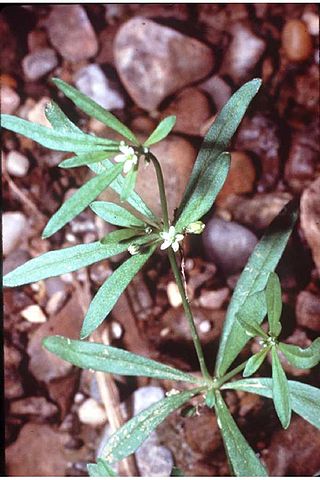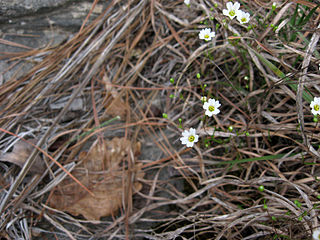
Caryophyllaceae, commonly called the pink family or carnation family, is a family of flowering plants. It is included in the dicotyledon order Caryophyllales in the APG III system, alongside 33 other families, including Amaranthaceae, Cactaceae, and Polygonaceae. It is a large family, with 81 genera and about 2,625 known species.

Gentianaceae is a family of flowering plants of 103 genera and about 1600 species.
There are over 190 vascular plant species on the Norwegian Arctic archipelago of Svalbard. This figure does not include algae, mosses, and lichens, which are non-vascular plants. For an island so far north, this number of species constitutes an astonishing variety of plant life. Because of the harsh climate and the short growing season, all the plants are slow growing. They seldom grow higher than 10 cm (4 in)

Minuartia is a genus of flowering plants commonly known as sandworts in the family Caryophyllaceae.

The Molluginaceae are a family of flowering plants recognized by several taxonomists. It was previously included in the larger family Aizoaceae. The APG III system of 2009 made no change in the status of the family as compared to the APG II system of 2003 and the APG system of 1998, apart from a reassignment of several genera, such as the placement of Corrigiola and Telephium into Caryophyllaceae, Corbichonia in Lophiocarpaceae, Microtea into Microteaceae and Limeum in Limeaceae, because the family was found to be widely polyphyletic in Caryophyllales. In addition Macarthuria was found not to be related to Limeum as previously thought and thus it was placed in Macarthuriaceae, and similarly species formerly placed in Hypertelis, apart from type species Hypertelis spergulacea, a true Molluginaceae, were found to belong elsewhere and were described as Kewa in the family Kewaceae, named for the Royal Botanic Gardens Kew. Molluginaceae is still assigned to the order Caryophyllales in the clade core eudicots, although the generic circumscription is difficult because Mollugo is not monophyletic.
Minuartia decumbens is a rare species of flowering plant in the family Caryophyllaceae known by the common names The Lassics sandwort and Lassicus stitchwort.

Minuartia stricta is a species of flowering plant in the family Caryophyllaceae known by the common names bog stitchwort, Teesdale sandwort and rock sandwort. It has a circumboreal distribution, occurring throughout much of the northernmost Northern Hemisphere from the lower Arctic into the alpine climates of mountainous areas in temperate Eurasia and North America. It grows in several types of habitat, including meadows, marshes, heath, beaches and bars, and arctic and alpine tundra.

Minuartia uniflora, the one-flower stitchwort, is a species of flowering plant in the family Caryophyllaceae. It is native to the Southeastern United States where it is primarily found in the Piedmont. Its preferred habitat is sandy or granitic rock outcrops.

Cherleria is a genus of flowering plants in the family Caryophyllaceae, found in the Arctic and mountain areas of the northern hemisphere. Its center of diversity is the Balkans. The species shows ecological differentiation and multiple colonisations of alpine habitats. It was enlarged in 2017 with species from other genera.

Eremogone is a genus of flowering plants in the family Caryophyllaceae, native to western North America, northern Asia, eastern Europe and northeastern Africa. Attempts to resolve taxonomic relationships within the Caryophyllaceae have resulted in the enlargement of Eremogone with species from other genera.

Eudianthe is a small genus of flowering plants in the family Caryophyllaceae, found in the Canary Islands and the western Mediterranean. It can be distinguished from other members of the tribe Sileneae by its linear to narrowly lanceolate leaves and its pink flowers.
Bolanthus is a genus of flowering plants belonging to the family Caryophyllaceae. It includes 21 species native to the eastern Mediterranean, from Greece to the Sinai Peninsula.
Pseudocherleria is a genus of flowering plants belonging to the family Caryophyllaceae.
Mcneillia is a genus of flowering plants belonging to the family Caryophyllaceae.
Minuartiella is a genus of flowering plants belonging to the family Caryophyllaceae.

Mononeuria is a genus of flowering plants belonging to the family Caryophyllaceae.
Minuartia krascheninnikovii is a species of flowering plant in the sandwort genus Minuartia, family Caryophyllaceae, native to East European Russia. It is found in the petrophytic steppes of the southern Ural mountains.
Minuartia mediterranea is a species of plants in the family Caryophyllaceae (carpetweeds).

Sabulina is a genus of flowering plants in the family Caryophyllaceae. It includes 74 species native to temperate and subtropical North America, Eurasia, and North Africa.
Dichodon is a genus of flowering plants in the carnation family, Caryophyllaceae. It includes seven species native to temperate and boreal Eurasia and Morocco, Greenland, and eastern Canada.











